Friday 13th has been regarded with superstitious dread for many years, so it is perhaps appropriate that Friday 13thJuly 2018 marked the end of the Rudolf Steiner School Kings Langley. Barring unforeseen developments, the school has now closed its doors for the last time after falling foul of Ofsted, and the future of its historic site and the present school buildings are currently uncertain. As a result of the closure, parents and pupils are having to search around for any new schools that still have room to take them, and the teaching and administrative staff will be scrambling to find new jobs after being made redundant.
I worked at the school for a number of years up until 2014 and my daughter received a good education there, so naturally I am sad that the school has come to such a sorry pass. I will have more to write about all of this in a future post but first I would like to give some idea of how the school came to be founded, together with an appreciation of the rich heritage that is now being so carelessly destroyed.
The school sits on the site of the 13thcentury royal palace of Kings Langley, built by Queen Eleanor, the wife of King Edward I, between 1279 and 1281. The king and queen had a great interest in the work of the Dominicans, and they may even have met the Dominicans’ most prominent teacher, Thomas Aquinas, during their travels in the Mediterranean, where they had been four years on crusade.
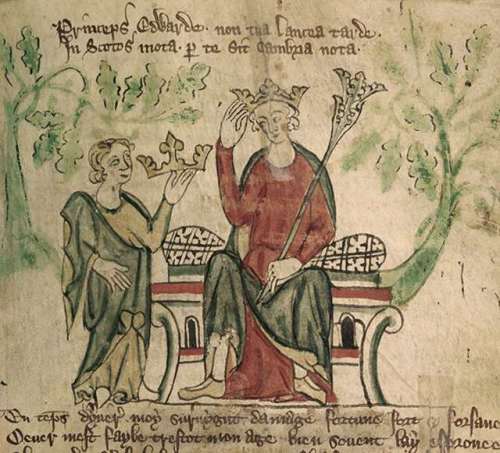
Edward II receiving the crown of England. (Image from a contemporary manuscript, copyright of the British Library Board)
Their son, Edward (who became Edward II in 1307), inherited the lands and the palace in 1302, and he established a Dominican friary there in 1308. Edward had grown up at Kings Langley and it was one of his favourite places. He was often under the influence of his court favourite, Piers Gaveston, and they may have been lovers; whatever the reason, his reign was considered to be disastrous for England and he was eventually deposed in 1327 by his wife, Queen Isabella and her lover Roger Mortimer. Before this, in 1312, an assembly of barons had hunted down and killed Piers Gaveston, to the king’s great distress. Gaveston had been excommunicated and so a proper burial for his beheaded body could not be arranged until the king had arranged a papal absolution for his favourite. This happened in 1315 and Gaveston’s body and head were brought to be buried in an elaborate ceremony in the Friary at Kings Langley.
Other kings and queens of England also lived at the palace: Edward III, who used Kings Langley as his seat of government during the Black Death in 1349; his fourth son, Edmund of Langley, the first Duke of York and the founder of the White Rose faction in the Wars of the Roses, has his tomb in the parish church; King Richard II held court and issued proclamations from the palace, and his court spent Christmas at Langley. The palace at Kings Langley is mentioned in Shakespeare’s Richard II. Richard was assassinated in 1400 and his throne was seized by the man who became Henry IV. After Richard’s death, Kings Langley went out of favour as a royal palace, although Henry V spent some time there in 1414. In 1431 there was a disastrous fire that caused extensive damage, after which no kings or queens lived there. The Friary church, which was consecrated in 1312 and could hold up to one hundred friars, survived until the 1500s when Henry VIII dissolved the monasteries and seized their assets for himself. In 1631, Charles I sold off the palace and priory to pay off debts owed to the City of London. This ended three centuries of royal association with Kings Langley.
Today there are no visible traces of the palace and only one building that remains from the Friary, which is nowadays somewhat confusingly called the Priory. This royal and religious history was as much as I knew about the site, until one day I was visited in my office by the school’s excellent librarian, Daniel Bryan. Daniel told me that he had been walking in the churchyard of Kings Langley Parish Church and had come across an unusual and interesting grave, with a bench besides it that was obviously connected with the grave. The grave was in a poor state and had been vandalised and was covered with litter and rubbish, but there was something about it that made Daniel want to clear it and investigate further.
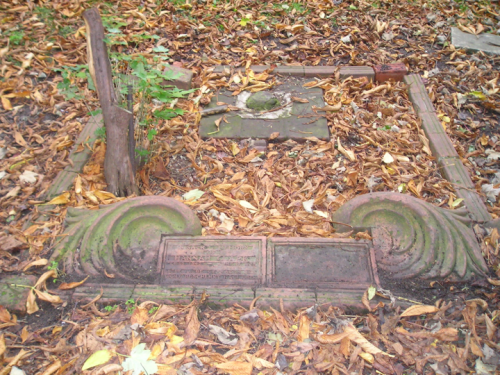
The remains of the grave of Hannah Clark in the cemetery of Kings Langley Parish Church.
This grave turned out to be the burial place of Hannah Clark (1845 -1935), one of the two founders of the first school on the site of the palace and friary. I decided to do some further research into more recent history and discovered that Hannah Clark was a pioneering teacher who had started a co-educational boarding school – this must have been a daring concept in Victorian times. Sometime in the 1890s, she was joined by another teacher, Margaret Cross (1866 – 1962), who had been educated at the University of Cambridge but, being a woman, was not allowed to graduate. (Although women entered Cambridge lecture halls slightly earlier than those at Oxford, Oxford was the first of the two to admit women to degrees and full status in 1921 and, astonishingly, it would be another 26 years before Cambridge followed suit in 1947.)
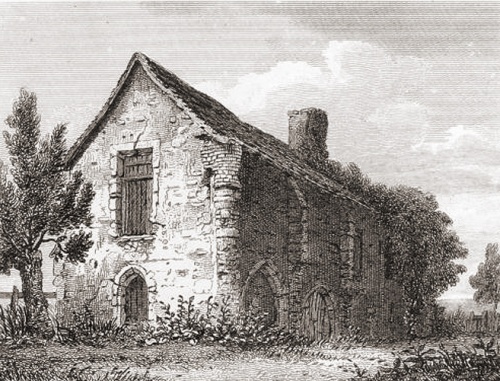
The ruins of the Priory at Kings Langley in an engraving from 1816. It can’t have looked much better in 1909 when Miss Cross and Miss Clark decided that this was where they would build their new school.
By 1899 Hannah Clark was running a school in Coombe Hill House, East Grinstead, Sussex. In 1909 Miss Clark and Miss Cross had found another site for their school, the ruins of the Priory at Kings Langley in Hertfordshire, which was being used as a farm outbuilding. They engaged the leading arts and crafts architects of the day, Parker & Unwin (also responsible for Letchworth Garden City) and got them to restore and extend the Priory and outbuildings so as to provide a home for the school, which was soon to be renamed The Priory School. The school opened in 1910 and the 1911 census records Miss Cross and Miss Clark as joint principals, living there with the 80-year old Norman Cross, Margaret’s father. At that time there were sixteen pupils, three servants and two assistant teachers.

A photo of unknown date, believed to be of Hannah Clark.

The ruins of the Priory, before Parker & Unwin began their work.

The Priory transformed by Parker & Unwin, with the addition of two wings to the older building – a most attractive and sympathetic piece of architecture in the arts and crafts style.
Miss Clark and Miss Cross were advanced educationalists and decided to run their new school on Montessori lines. In around 1920, the two women became interested in Rudolf Steiner’s new Waldorf school in Stuttgart, and in December 1921 Miss Cross was invited to join the New Ideals in Education committee on a visit to a course given by Rudolf Steiner at Dornach. The trip was organised by Millicent Mackenzie, who was a professor of education at University College of South Wales and Monmouthshire, the first female professor in Wales and the first appointed to a fully chartered university in the United Kingdom. She wrote on the philosophy of education, founded the Cardiff Suffragette branch, became the only woman Parliamentary Candidate in Wales for 1918, and was a key initiator of Steiner Waldorf education in the United Kingdom.

Professor Millicent Mackenzie in 1915.
Millicent Mackenzie, who had first met Steiner in August 1921, arranged for him and some of the Waldorf teachers to give a lecture cycle and supporting programme for British teachers to take place at the Goetheanum at Christmas 1921. Around forty people responded to her invitation, travelling from England to Dornach, where Rudolf Steiner held the lecture cycle Soul Economy – Body, Soul and Spirit in Waldorf Education in the White Room of the newly-built Goetheanum, that same room in which the disastrous fire was to break out just a year later.
Miss Cross knew not only Latin and Greek but was also fluent in German, so my assumption is that this is why she, rather than Hannah Clark, went to Switzerland to take part in the course. According to Helen Fox, who also attended the lecture cycle, “it was on the occasion of this Dornach course that Miss Cross, headmistress of a boarding-school at Kings Langley, offered her school to Dr Steiner, to be remodelled on anthroposophical lines.”
According to another attendee, Alexander Strakosch: “From talking with English listeners it was especially interesting to hear how little state officials in England interfere in the essentials of education and teaching. They have there a whole lot of non-state schools, and anyone who just wants to put pedagogical ideas into practice or to live out of good ideas will not have numerous difficulties put before them. At first many of these English teachers therefore had little understanding for the concept of free spiritual life. They thought (…) that in their country they already had it, for they could do what they liked. To grasp the concept of free spiritual life was hard for them.” How very ironic such a statement will seem to Steiner school teachers today…

Rudolf Steiner circa 1922
On her return to Britain after the lecture cycle, Millicent Mackenzie then initiated a conference on the themes of Shakespeare, drama and education in Stratford-on-Avon in April 1922,to which she invited Rudolf Steiner. Miss Cross invited Steiner to visit the Priory School on his way to this conference and thus it was that on Sunday April 16th 1922 the school at Kings Langley became the only school in the UK ever to have been visited by Rudolf Steiner. Steiner himself gave an account of this visit when he got back to Dornach:
“I and other friends took up an invitation from Miss Cross, who showed us over her school at Kings Langley. (…) We could see how a number of children are brought up and educated in a boarding school of this kind. It is extremely interesting how children are (…) brought into proximity with life out of certain ideals of the present. The roughly forty to forty-five children in the boarding-school have to do everything; there are actually no servants there. The children have to get up early and care for the whole institution themselves, as well as cleaning their own shoes and clothes. They have to make sure there are enough eggs through breeding poultry, which they also do, and various other things you will be able to think of. They clean everything themselves, cook everything themselves and look after the garden. They have themselves first grown, harvested and cooked the vegetables which come onto the table, and then also eat them. A child is thus led into life in a many-sided way and learns a whole mass of things.
During the Christmas course Miss Cross formed an intention to organise this boarding-school in the manner of a Waldorf school. This is being considered as a quite serious plan. Mrs Mackenzie, who was also one of the chief moving forces for my being invited to the Shakespeare festival, is very much in favour of our school movement, supported by anthroposophy, winning a certain terrain in England. There is now an endeavour to form a committee for organising this school from an anthroposophical background, according to our education.
This will be a very significant and important step forward. If so energetic a will stands behind it as exists in the personalities of Miss Cross and Professor Mrs Mackenzie, it can be taken for granted that after various hindrances are overcome, something of the kind will be able to come about.”

The Priory School, showing the additional wings by Parker & Unwin on each side of the remains of the old Priory building. This is how the school would have appeared to Rudolf Steiner during his visit on Sunday 16th April 1922.
Millicent Mackenzie and Arnold Freeman (warden of the Sheffield Educational Settlement) then joined together to bring awareness of Rudolf Steiner’s educational ideas into English teachers’ organisations and arranged a further conference in August 1922 at Manchester College, Oxford on “Spiritual Values in Education and Social Life”. Millicent Mackenzie also organised a public lecture by Rudolf Steiner on education on 30 August 1924 in Essex Hall, London, under the auspices of the Educational Union for the Realisation of Spiritual Values and she gave the welcoming address. Through her efforts the founders of Steiner Waldorf education in the United Kingdom were introduced to these ideas and built up the first schools.

Almost the only photo I have been able to find of Miss Cross is in the group picture taken at the Oxford conference in 1922. Apart from Rudolf and Marie Steiner, there are some distinguished anthroposophists in the photo, including Edith Maryon, Eugen Kolisko, Harry Collison, Margaret McMillan, Millicent Mackenzie, Caroline von Heydebrand, Ilona Schubert, George Adams, Baron Arild Rosenkrantz, Juliet and Vera Compton-Burnett and several others. Miss Cross is at the top right of the picture, on the end of the 6thor 7throw, the small lady without a hat standing just below George Adams.
So as to help Miss Cross with the new direction for her school, a committee was formed to provide practical training support in Waldorf methods. A teacher was sent from Kings Langley to the Waldorf school in Stuttgart, with Miss Cross herself soon to follow. Steiner also sent to Kings Langley from the Goetheanum two English women (Juliet and Vera Compton-Burnett, sisters of the novelist Ivy Compton-Burnett) who had trained at Dornach. George Adams, who was Steiner’s translator whenever he was in England, was also a member of this committee. A little later, Adams, Miss Cross and the Compton-Burnetts were present at the Goetheanum to attend the lecture cycle on The Spiritual Communion of Man at New Year’s Eve on 1922, and thus they were present when the Goetheanum was burnt to the ground. The same group was also present at the 1923 Christmas conference, when Steiner gave the Foundation Stone Meditation – so these people took part in some of the seminal moments in anthroposophical history.
In December 1922, Rudolf Steiner sent a Christmas present to Margaret Cross. It was a verse, now known as the Kings Langley Grace:
As quicken the roots in the night of the earth,
As the leaves unfold through the power of the air,
As ripens the fruit in the might of the sun,
So quickens the soul in the shrine of the heart,
So unfolds man’s spirit in the Light of the World,
So ripens man’s strength in the glory of God.
And root and leaf and the ripe fruit’s blessing
Support the life of men on earth
And soul and spirit and the strong deed’s action
May raise themselves in gratitude to God.
But by August 1923, Miss Cross had somehow managed to fall out with most of her committee of helpers. Steiner wrote to Edith Maryon from Ilkley in Yorkshire, (where he was giving another course of educational lectures, presided over by the excellent Margaret McMillan) in which he said: “The committee once created to reorganise the Kings Langley School now consists only of Mrs Drury-Lavin; all the others have resigned. The plan of doing something with Miss Cross they consider hopeless. She herself is most distressed about it.”
The problem, it seems, was that Miss Cross could never quite reconcile herself to the idea of the school being run by a College of Teachers; and so it was that Michael Hall, formed in 1925 as the result of a request to Steiner at that Ilkley gathering, had the honour of being acknowledged as the first proper Waldorf school in the UK.
Miss Cross nevertheless persisted with her school along Waldorf lines, even after the death of her partner Hannah Clark in 1935. It must have been at that time that Miss Cross designed the grave and the bench, as a memorial for both Hannah Clark and her late father, Norman Cross. Both the grave and the bench bear powerful testimony to the creative and intellectual distinction of Margaret Cross. There are two name plaques on the grave, one with wording in memory of Hannah Clark, the other one is blank – perhaps Miss Cross had envisaged that the second plaque would be for herself – but I do not think that she was buried there, and I’ve not yet been able to find out where her remains now lie.
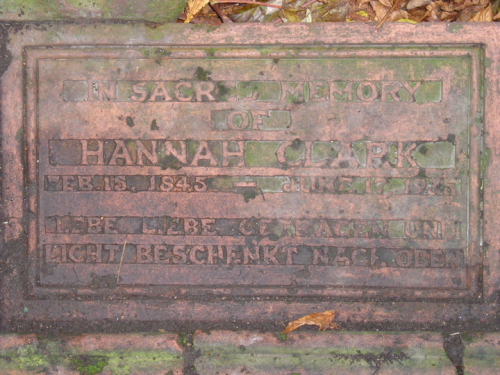 The wording on Hannah Clark’s plaque is:
The wording on Hannah Clark’s plaque is:
“In Sacred Memory of Hannah Clark
February 15th 1845 – June 17th 1935
Lebe Liebe getragen und
Licht beschenke nach Oben.”
Daniel Bryan tracked these German words down to a lecture by Steiner: Der Tod – Die Andere seite des Lebens (Death – the other side of life) and translated them as follows: “Live carried by love and Blessed by light ever upwards.”

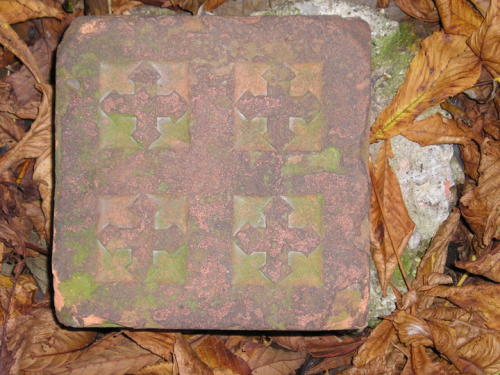
Both the grave, or what is left of its sculptural work, and the bench, which is still complete, are striking examples of the arts and crafts style. The beauty of the wings around the inscription seem to be the wings of love as described by the quotation from Steiner. The details of the cornerstones depict four crosses, a reference to the Christian symbol and the family name.
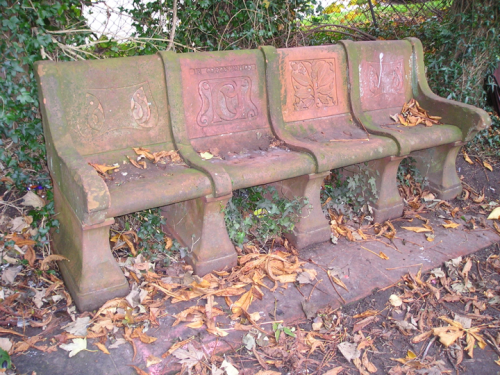
The backrest panels of the bench are of great interest as they appear to depict anthroposophically significant motifs: celestial lemniscates right and left, and on the right centre panel the tree of life, with a cocoon, a caterpillar, a butterfly and seedlings encompassed by a heart, all executed with great craftsmanship. My assumption is that all of this was designed by Margaret Cross.

After Hannah Clark’s death, Miss Cross continued to run the Priory School. Then in 1949, in apparent deep frustration at her unwillingness to change, almost all of her teachers broke away from her with the intention of starting a new school. This they did, buying two buildings right next door to her school, and taking with them most of Miss Cross’ pupils. This led to a court case against them, which was reported in great detail by the newspapers of the time. Miss Cross alleged that the teachers had formed themselves into an association in 1945 which had gradually sought to obtain the control of the school from her. She claimed a declaration of her right to the ownership of the school and certain furniture, and also sought an injunction to restrain the teachers from starting a similar school in the two houses adjoining her premises.
The judge trying the case was obviously intrigued and amused by everything he was hearing and said at one point: “Steiner seems to have told the teachers how to do everything except how to get on together without a row.” He gave judgment against the teachers, or “this very peculiar body” as he called it: “What conceivable right they had to sack the head mistress passes my comprehension. They took leave not only of their manners but also their senses. In this particular case the College of Teachers got its heads so far into the clouds that it forgot or omitted to keep its feet on solid earth.”
The Daily Express was also amused by the case, reporting that “Miss Margaret Frances Cross – ‘I am over 70, but I don’t see why I should make my age public’ – (she was actually about 83 years old at the time) arrived in Kings Langley last night and surveyed the school for which she had fought and won – the Rudolf Steiner School. One hundred yards away six teachers against whom she had gone to law were arriving back at Priory House, one of two hostels they own as an association.”
How very galling it must have been for Miss Cross that these teachers had set up their new school right next door to her school, had poached most of her pupils and left her with just two teachers. Likewise the teachers must have had their difficulties with Miss Cross, who was reluctant to have a College of Teachers, didn’t pay them well, probably kept them short of necessary resources and whose style of teaching they may have found impossibly old-fashioned.
So the New School, as they rather unimaginatively called it before the name was changed to Rudolf Steiner School Kings Langley, was founded as a result of disagreement and was located on a site which had seen a great deal of historical, spiritual and political turbulence. Have the energies of this place contributed to the present disastrous outcome, I wonder?
Miss Cross continued to run The Priory School with much diminished pupil numbers until 1955, and she died at the age of 96 in 1962.
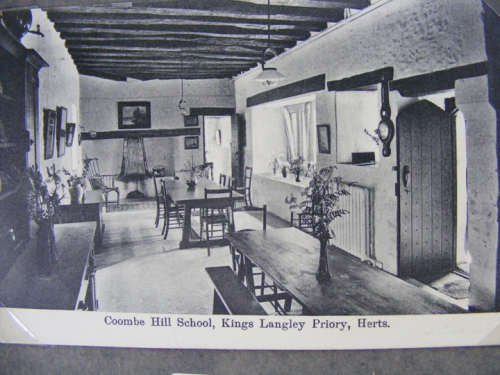
An interior at The Priory School, showing the simple, austere yet tasteful style adopted by Miss Cross and Miss Clark.
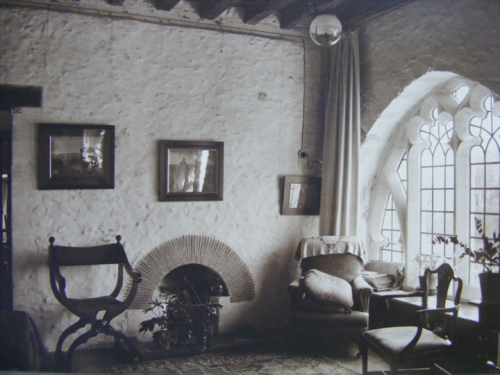
One end of the room in the old part of the Priory which Miss Cross called the Locutorium, where her visitors would be received.

A classroom in the old part of the Priory.
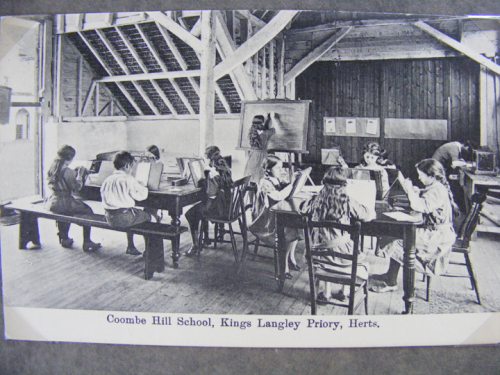
An art class in the Barn, one of the outbuildings at the Priory.
Although Miss Cross was an educationist of considerable standing, a highly educated and cultured woman, perhaps it could be said that in her school she wasn’t able to give expression to the full potential of Steiner Waldorf education. But she was also a pioneer of the Christian Community and one of the founders of anthroposophical agriculture in the UK, someone without whom the beginning of biodynamics in the UK could hardly have taken place. Carl Mier published some “Recollections of Margaret Cross” in the autumn 1962 issue of Star and Furrow:
“When I met Miss Cross first, she already gave the impression of an old person, old in the sense of ageless, and she hardly seemed to grow any older in the succeeding years. She was of small stature, bent, with a wrinkled face, but sparkling eyes. Her fingers were gnarled, her feet were encased in heavy shoes. One never met her but in heavy tweeds, carrying a large bag with papers and books. She lived in surroundings which seemed most befitting to her: a largish holding with many trees and bushes and shrubs, which gave at first sight the impression of neglect, until one discovered that more care was bestowed on it all than one thought. In the centre, the buildings of an old Dominican priory, modernised rather cleverly earlier this century, with farm buildings around. There was the same air of austerity in the house as one encountered in Miss Cross herself: an austerity in body-comforts, in meals, in light and warmth. And yet, it all had style. House and owner belonged together. When one opened the old-fashioned latch of her front door a spotlessly clean room greeted one, with that polish and almost loving austerity one meets in monasteries and convents. The bread she offered was home-made, the vegetables and fruit came from her own garden. All was simple, but all was the expression of Miss Cross.
She was one of the most learned and truly educated people I have ever had the privilege to meet. Her knowledge of English language and literature was profound, and alive. She was a classical scholar. And at my very last meeting with her – a few years before her death – I had a real surprise. She had broken her leg, and I asked whether I might see her to discuss a difficult matter over which in the past we had never quite come to an agreement. I was shown into her bedroom – furnished like a cell. There she was, undaunted by her age and her broken leg. She looked healthier than I had ever seen her before (it was probably the first time for years that she was warm and rested and properly nursed). She was in the most amiable mood, and our problem was settled within minutes. During a most animated conversation which made me forget her almost 90 years, I looked at the pile of books on her bed and bedside table. Next to a few books by Rudolf Steiner there was a whole collection of volumes on very advanced higher mathematics. ‘At last I have a chance of reading something about this. I have wanted to do so for a long time!’ Her eyes sparkled, and with her gnarled fingers which could hardly move she showed me some passages which had ‘thrilled’ her.
I think Miss Cross was a lonely person longing to do what this life had made difficult for her to accomplish. She was so strong a personality that co-operation with others did not come easily to her, and thus one missed in her school, for instance, that ‘College of Teachers’ which is an integral part of a Rudolf Steiner School. But she loved children so much that she taught almost to the end of her life.”
What Margaret Cross and the other teachers who worked so hard to establish Waldorf education at Kings Langley, and who are now in the spiritual world – I’m thinking of people like Nat, Philip and Moana Bowron, the Compton-Burnetts, John Wells, Heather Thomas – must be making of the present debacle, I can scarcely imagine. I shall be contributing my own thoughts on this death of a Steiner school in a future post.

Thank you for this most interesting and informative article. Both my children attended Kings Langley.
LikeLike
I was pointed to this post after I enquired about who was NC on the terracotta bench in Kings Langley church ( Kings Langley remembered UK). Although the second seat is not mentioned in the article it is probably in memorial to Margret Cross’s Father Norman Cross.
LikeLike
Dear Jeremy,
You bleed the heart with your sentimentality and historical touchstones, and this is what makes you an outstanding essayist in today’s anthroposophical world. Indeed, the closing of the Kings Langley school is a misgiving, but it seems to have shown all of the prior signs of poor performance, student behaviour, and other malfeasance that makes for the end of something that was meant to be good.
So, what can I say? It happened, and it seems that it wouldn’t have happened if everybody was happy. Yet, everybody wasn’t happy with the situation at Kings Langley. So, what went wrong?
In today’s world there are certain factions that are opposed to the science of the spirit, and even teaching the precursors to this system is opposed. Thus, Waldorf Schools are opposed by the forces of present-day educational parameters. This is why schools like RSSKL are being assaulted by today’s standards of materialism.
Please let me make a personal remark. This year is when my graduating class in 1968 celebrates its 50th reunion, and yet, it was all about dead lifeless thoughts and constructs that only serves a materialistic worldview. This is what we were taught. The world’s students are taught this dead lifeless system, even now.
So, make of it what you will. Kings Langley never had to close, and yet forces external were opposed to what it sought to teach. That is the sum and the short of it. If Kings Langley had been allowed to teach the principles of the Waldorf education that Rudolf Steiner had first brought forth with the Stuttgart school in 1919, then it would have proved successful. Yet, certain forces by 2014 were against it.
What could they be?
LikeLike
What a fascinating post. Loved the history lesson!
LikeLike
How very fascinating! Thank you for taking the time to write it all down and share with the world. I myself am pioneering a Waldorf school together with a partner. I’m always ready to learn from other schools’ experience.
LikeLike
Cross seems to be a real character from Compton-Burnett’s great and painful novels! The closure of Langley is not so much a sinister plot, but rather the consequence of a Manichaean distrust of the government and of state officials.
LikeLike
Nobody said it was a sinister plot, but much more of the nature of government officialdom, as you say. In England, they have something called “Ofsted”, which is a branch of the UK government and measures officially designated standards of education, child services, and skills. Ref, https://www.gov.uk/government/organisations/ofsted
So, in England, all schools, whether public or private, have to meet these Ofsted standards. Thus, a Rudolf Steiner school stands to come under greater scrutiny for its inherent curriculum goals, which Steiner addressed in his seminal course for the Department of Education, Basel, Switzerland, in April/May of 1920, ref., “The Renewal of Education”.
Here in America, private schools can teach what they want, and that is why some 123 Waldorf schools (Rudolf Steiner Schools) flourish without the invasive inspections dictated by governmental agencies such as Ofsted. Thus, freedom is seen as a personal choice made and allowed here. Education is one of those factors, and enables Waldorf schools to be successful without the restrictions imposed by government intervention, which is largely why RSSKL was forced to close.
LikeLike
You have hit the nail on the head, Ton. The school was closed because of a culture among many of the teachers which opposed any form of internal or external accountability, which militated against the school being able to comply with all the regulations around child-protection. I was a trustee there three times. It was a challenging role as one never knew whether one was being told the truth of any situation, yet in English law a trustee is held accountable for what happens in the institution. The college of teachers seemed to feel that they had been handed their own fiefdom, not accountable to the society in which the school was embedded and parasitic upon (as a charity).
Communication between the trustees and the college was either nonexistent or always compromised in some way. I came to feel that college management was the stupidest system of management I had encountered – and I had held senior positions in 4 different state schools and been involved in research in many others.
Steve Hale has it all wrong when he says, ‘ it seems to have shown all of the prior signs of poor performance, student behaviour, and other malfeasance…’ In fact the quality of teaching was generally good, the behaviour of the students was as good as any school I had seen, and I don’t know what Steve means by malfeasance. The school was well-managed financially after the appointment of an exceptional bursar about 15 years ago.
The school failed because they could not convince the OFSTED teams that they could manage safeguarding of children efficiently. In 6 visits by the inspectors over 18 months the school was only passed on safeguarding once and they immediately failed it again at the next visit.
LikeLike
I don’t know that I have it all wrong, but inspection standards usually include measurement of knowledge criteria, and maybe this was shown to be upheld at Kings Langley. Other schools have indicated poor standards of performance. With regard to RSSKL, the news updates have been far from being completely forthcoming, and so one must try to reason what it all means. This site is worth reviewing:
https://sites.google.com/site/waldorfstraighttalk/rsskl
LikeLike
Tom,
The gist of what you are saying seems to be that the school was actually working well, as far as you could tell, but that its leadership group couldn’t bring themselves to be responsive and open with any group they perceived as falling outside the charmed circle of school governance, be it Ofsted or be it the board of trustees. “The behaviour of the students was as good as any school I had seen” speaks very well for whatever was happening there.
Some of the safeguarding criticisms sounded like a clash of pedagogical cultures, which, if so, gives a new level of complexity to the story, even if the English reality is that you have to adapt to government bureaucracy, agree or disagree.
LikeLiked by 1 person
Thanks, Jeremy. for a story I wasn’t familiar with and so vividly told.
LikeLike
Thank you, I so appreciate the historical context. It is very instructive and revealing to get to know these pioneers.
LikeLike
My class 11 all left, broke up, at the end of the academic year in 1960, as the school, then called ‘The New School, decided they would not offer subjects for year 12 in 1961. I joined year 12 in 1960 for German A Level however with Vera Compton Burnet as our teacher; and was the only one from year 11, together with one from year 12 who also sat for French O Level that year. Strange to think of it continuing for another 58 years and then closing. I wonder what will happen to that first Kindergarten building designed by Edwin Ayre, my father, during the 60’s with the mosaic of St Francis on the outside which he made personally.
LikeLike
Good to hear from you, John – that kindergarten building is remarkable and beautiful, and one always felt the closeness of the angelic world while there. The mosaic of St Francis is lovely and always impressed visitors. Was your mother Anne Ayre, the wonderful music teacher?
Best wishes,
Jeremy
LikeLiked by 1 person
no, Anne was married to my brother Alexander who was one year ahead of me at school in that year 12 I mentioned. You may have come across another of Alexander’s classmates Keith Murray who married an exchange student from Germany Elizabeth who became the school librarian I believe.
LikeLike
As a pupil at the school from 1960 -71 I can remember seeing Mr Ayre every day walking to and from his mosaic in his overalls. I later went to see him in New Zealand. Benedict Ayre was a classmate.
LikeLike
Wow!
LikeLike
In my experience (at the international anthroposophical youth conference there in 1978) that kindergarten is one of the best designed in the world of Waldorf education, well shaped to embrace and support the children of that age, with many interesting little touches (like snail patterns in the concrete walkways).
LikeLike
Thanks for your comment, David. I hear that the kindergarten at RSSKL (which has always received “Outstanding” ratings in Ofsted inspections) is going to continue with two classes, so that is very good news. I agree with you entirely that the building is very well designed and its setting within its own lovely garden is also very special.
LikeLike
Could you also identify Juliet and Vera Compton-Burnett in the 1922 photo above of the 1922 Oxford Conference? They would have been pretty young then -maybe around 20 years of age?
LikeLike
I’m not absolutely sure, John, because I never had the privilege of meeting Miss Vera and Miss Judy as they were always known – but my best guess is that they are in the 4th row from the top, with Vera in the middle in a hat, then just on her left is Judy without a hat. They had both been trained in eurythmy at Dornach by Marie Steiner, and were sent by Steiner to help Miss Cross at Kings Langley.
Best wishes,
Jeremy
LikeLiked by 1 person
I think I can see the ones you mean, although they are not recognizable to me there. There is a series of panoramic photos of the whole school from 1974 which has many of the teachers I knew from 1956 to 1960, including the Compton-Burnett’s, I have downloaded but don’t know if it is possible/appropriate to post here. We had both C-B sisters for eurythmy classes, and Vera for English and German.
LikeLike
Pingback: on the demise of kings langley steiner school – the ethereal kiosk
A little messenger has informed me that our friend, or nemesis, Michael Eggert, has written an essay on his blog, which cites the pseudo-illustrious Caroline Sommerfeld as weighing in on the closing of RSSKL, and how Jeremy Smith has written here about it. Apparently, this closing of a Steiner school only further proves, somehow, of the inevitable and fatal relationship of Steiner’s doctrines with the alt-right movement in Germany, and its toxic effects elsewhere.
https://egoistenblog.blogspot.com/2018/09/caroline-sommerfeld-die-neue-rechte-und.html
For an article on the background of Caroline Sommerfeld, we have this article from the New York Times:
CS is a contemporary example of the convergence of anthroposophy and the right-wing movement in Germany, according to Peter Staudenmaier. Yet, she is married to a leftist philosopher from Austria, who is some 20 years her senior, and likely knows of, and appreciates the work of Rudolf Steiner.
LikeLike
According to this report, the two children of Sommerfeld and Lethen have now been banned/unenrolled from the Waldorf school in Vienna due to her far-right affiliations. While the father has misgivings about why it is taking place, it certainly helps to prove that Caroline Sommerfeld has no support from the side of anthroposophy/waldorf in her far-right aims.
As well, it also proves that a certain professor remains the “straw-man”, as previously indicated, for his grossly exaggerated claims of a far-right movement in anthroposophy. Propaganda is so easy, and why this news article is a blessing.
http://www.faz.net/aktuell/feuilleton/hoch-schule/schule/waldorfschule-wien-schulverweis-wegen-neurechter-mutter-15775010.html
LikeLike
I’m mildly embarassed to report that my first memory of Miss Judy is when in a class one eurythmy lesson I had a small bladdrer control accident after which she accompanied me to the lavatories.
More pleasant memories are of a class outing a few years later in which we spent all day at the Compton-Burnett house hosted by Miss Vera and Miss Judy in (I think) Berkhamstead which had a lovely garden
Hard to say if the ladies you have identified in the Oxford photo are indeed them as they were much older when I knew them.
LikeLike
Hello Martin,
Thanks for your memories of Miss Vera and Miss Judy. I used to live in Berkhamsted and got someone to point out to me the house where the two ladies had lived. I was told that the person who had bought it after them had gutted and almost totally reconstructed it, so there was very little left of the original house. Other changes the ladies would not have enjoyed included the new Berkhamsted bypass(A41 road) having been routed towards the back of their property. There is some interesting information about them and their family (their father was a homeopath and their sister was the novelist Ivy Compton Burnett) in the biography of Ivy written by Hilary Spurling.
Best wishes,
Jeremy
LikeLiked by 1 person
Hi Jeremy,
Thanks for the update on the misses Judy and Vera’s house. Doesn’t sound as though it is the tranquil refuge anymore that I recall from our class 4 outing in 1964. It was a whole different world back then.
I shall have to have a look at the biography by Hilary Spurling.
I really appreciate you having written a detailed history of the school. It contains several fascinating nuggets such as the knowlege that RS made his one and only visit to a British Waldorf school at Kings Langley and that the prior name ‘The New School’ arose as a result of a breakaway exodus by disgruntled teachers formally employed by Miss Cross at the Priory. Gotta wonder about the laws of karma: bad vibes at the beginning engendering worse at the end perhaps…
Is there a way to edit posts on this site? I’m embarrassed to see I spelt embarrassed with only one ‘r’ above….
LikeLike
Hi again Martin
Just reread your last paragraph above and I note that the second ‘r’ from “embarrassed” is not entirely absent – just go relocated to give extra resonance to your word “bladdrer”. Such are the artistic vagaries (which I share in abundance) of good Steiner education!
Is it possible to continue some correspondence outside this blog spot? I would be interested to hear more about your take on shared experiences in Mrs Dubrovic’s class that may not be of general interest here.
Love the photos of your adopted part of the planet.
Cheers
Ben
LikeLiked by 1 person
Hello again Ben,
Any word worth its salt is worth spelling several ways don’t you think?
Glad you liked the Peru photos.
I’d be glad to discuss our shared early educational experiences. My email is martinstevens@juno.com
all the best
Martin
LikeLike
Hello Classmate
I recall that visit to Miss Vera and Miss Judy’s place. As I remember it we disgraced ourselves and had to write letters of apology for the extensive damage we caused to the garden. One letter (was it yours?) gave them great amusement (I had access to inside information): it apologized in list form for all the damage we had caused and then said that we had all had a wonderful time and looked forward to our next visit!
Was it your farm we visited once? I think I might still have a drawing of a (?jersey) bull that I made following.
All the best from New Zealand
Benedict
LikeLiked by 1 person
Hello Benedict,
Yes that was my uncle David’s farm at Lechlade in Oxfordshire, the location of the highest lock on the River Thames. The bull lived in his own paddock and was always a source of some childhood fear for me.
I had forgotten about the damage to Misses Vera and Judy’s garden. What naughty children!
All the best to you for 2020 over in NZ. I live in the Amazon jungle of Peru.
See wwwperucalling25.blogspot.com for photos and text of some small Waldorf projects we have going on here.
BTW I took my Peruvian wife Lourdes to see the kindergarten at Kings Langley a few years back and we enjoyed viewing the marvellous ceramic mural done by your dad. I can still remember him walking to and from the site of the mural in his overalls and a beret for an extended period as he worked on it.
Martin Stevens
LikeLiked by 1 person
Yes, Vera and Judy used to arrive and go again by chauffeur driven car. I also have trouble identifying them in the photo. I was a pupil during 1956-1960, Nat Bowron was our class teacher before going on to the upper school. Edwin Ayre, my father, taught there for about ten years and was responsible for the separate kindergarten building including personally making the mosaic of St Francis (I think it was). But I thought the school was allowed to open again with new staff. etc.
LikeLike
So the conversation ends in late September 2018 and the digital world, as does the real word, moves on. I was shocked and saddened to learn just now of the closing of the school, where during the mid 1980s I received my first introduction to a freer way of teaching from Anne Ayre, and her inspiration was such that I have sought to follow her example through all my teaching career, mostly outside Steiner Schools, but abroad in many places where fewer restrictions were imposed by officialdom on pedagogy. The tale of profound conflicts marking the history of the school has sad resonances for me, having participated in the pioneering school at Tremadog, also failed, and much later, at Forest Row, briefly. In spite of it all, and all the faults that have been identified in Steiner education by various, mostly self-styled, educational experts, I firmly believe that the movement in the UK has been on balance a force for good, the ultimate benefits of which we have yet to fully appreciate in its many students in this ‘agitated and expectant age’ (Gladstone).
LikeLiked by 1 person
Thank you, Kees. I agree with your conclusions and hope that, despite or even because of the present difficulties, Steiner schools will be able to adapt so as to be here for children for many years to come.
LikeLike
Anne Ayre was a sister-in-law I never met. But re the future, here in a part of Australia, there are now several RS schools. One advertised what it offered as enabling children to recognise the true, the beautiful and the good. This compares with the usual information from other schools of how their pupils have gone on to join the various professions. Via study and reflection, one can appreciate the value of the RS school’s offering…
LikeLike
Vera and Judith’s cottage was at Northchurch the next village from Berkhamsted. I jumped out of their upstairs window when I visited in late 1950s. I remember Ruth Ayre but cannot remember where from. My main teachers were Joan Smith and Ken Jones and they were excellent.
LikeLiked by 1 person
What an enlightening history…almost all of which I never knew!. Having joined the school in 1948/9 at a very early age I have memory of the turmoil. I recall boarding and being taught in the main building, Priory house, and actually walking to the kindergarten through a wicket gate by the poplar trees…..to be taught in the actual priory itself. After a few(?) years in Priory house I was moved to Friarswood for the remainder of my eleven and a half years at The New School. My teachers were the Compton-Burnett as well as the Burowns and Mr Wells as a very forward thinking ‘gym’ teachers…we did football, cricket, tennis, netball, discus, hammer, javelin as well as normal PT…and that in the mid fifties.
Alex Ayre and Keith Murray were two of my class mates…I was always pleased to see our black and white class photo on the old scholars page..on the back of my copy I have all their signatures so remember all the names.
Happy days and very very sad to read of the schools demise.
I have no regrets over my schooling and remain sure that the basics of a good life were formed at the school.
John Baker. 1948/9- 1959.
LikeLiked by 1 person
Thank you for your kind words and very interesting memories, John!
LikeLike
Alex Ayre – my older brother. Remember Keith too. Joined them for German A level when they were in year 12 (I was in year 11 then). There were just 6 left in year 12, must have been 1960, but I don’t remember your name John Baker.
LikeLike
Hi Jeremey,
Thanks for nice reading.
I am working in Denmark in the archiv from Arild Rosenkrantz – Do you have a better photo of the group picutre Oxford conference in 1922? I cant see Arild Rosenkrantz. Do you have any other record about Arild Rosenkrantz.
Best regards Leander
LikeLike
Hi Leander,
I found the photo of the Oxford 1922 conference in the archive of the library at Rudolf Steiner House in London. As far as I remember, it was a good quality print, presumably from a large-format negative, but I don’t have a copy of it myself. You could try contacting the librarian at Rudolf Steiner House to enquire if they could make a copy for you. In that photo, Arild Rosenkrantz is the man with a beard, seated second from the right in the second row. The woman to his right is Tessa Rosenkrantz.
Best wishes,
Jeremy
LikeLike
I went to this school in the 90s, and I have family who worked there, notably during the time when the school was closed. My teacher when I was there was later involved in the controversy leading up to the closure.
When we were in year 3, this teacher would place his hand on our bottoms when we went to speak to him. I found this really unpleasant and frightening and avoided ever having to speak with him. One of my classmates, a girl, complained to her step father who then complained to the school. Rather than the teacher ever facing any consequence, the family were forced out. This was almost 25 years ago, thus teacher stayed on and went on to act inappropriately with children.
My brother’s teacher was also involved in controversy involving inappropriate contact with a child.
I find the historicizing and conspiratorial angle of your article, Jeremy, to be indicative of the attitude of this school, outsiders are viewed with suspicion, and criticism is viewed as misplaced or as part of an effort to demonize your alternative education and is turned back on the accuser in the worst possible case of victim blaming.
My experiences of being educated at a Steiner school, and knowing many people involved in the school (including close family) remind me of many descriptions of cults.
LikeLike
RSSKL had several serious faults, which is why it was closed down by Ofsted. It’s a huge disappointment to me that such serious failings by individual teachers has besmirched the name of Steiner Waldorf education in the eyes of many people. I’m sorry that you and your brother had less than ideal experiences at RSSKL – to my mind this is inexcusable and totally contrary to Rudolf Steiner’s intentions for an educational method that is truly human and based on the natural development of children.
LikeLike
Jeremy Smith, this is disengenious or self deluded; any cursory search will throw up experiences like the one above; this sort of behaviour is a thread running through Steiner schools all over the world ; what other school system has a “survivors group” , huge and numerous critic groups, websites and critical articles? There is secrecy, lack of openness and closing rank, a lot to do with the esoteric root of anthroposophy, the denial of its central importance and what must be confusion, and desire to belong and conform to the group. Like a cult.
LikeLike
Lyra, any cursory search will reveal such experiences in all countries, in all walks of life, in all sorts of schooling systems, etc. What is disingenuous is for you to imply that this is a special feature of Steiner schools. It most certainly isn’t and where it has occurred in Steiner schools, it is of course utterly disgraceful.
I think it is a feature of our age that this buried shadow of aberrant human behaviour is coming to the light of day in shockingly vast statistics; for example, I read in the Financial Times yesterday, that 1 in 10 people in France claim to have been the victims of incest; and today, BBC Radio 4’s ‘File on 4’programme is about the issue of female-perpetrated child sexual abuse, which is far more common than supposed.
The accusation that Steiner schools are some kind of cult is often made but it is complete nonsense. I have written about this in more detail here: https://anthropopper.com/2016/02/12/no-mr-dugan-steiner-waldorf-schools-are-not-cult-schools/
This topic raised by you and Anonymous is way off the original post so I don’t propose to accept any more comments here, unless they are to do with Margaret Cross and the founding of the school at Kings Langley.
LikeLike
@jeremysmith333 – you say ‘Almost the only photo I have been able to find of Miss Cross”… – I’ve been working on a history of biodynamics in the UK and she features large – particularly between 1935 and 1951 – and I would love to have another photo of her. (So far I’ve just used yours – see https://considera.org/wpwp/miss-cross/
LikeLike
Alas, I know of no other photos of Miss Cross. The other photo I found was in the newspaper reports of the court action she took against the teachers who broke away from her school, and she was in her 80s at that time.
LikeLike
I don’t suppose you got a copy of that. She seems to have been quite camera shy huh.
LikeLike
Sorry, no, I don’t have a copy of that photo. I found the press cuttings in the library at Rudolf Steiner House in London.
LikeLike
Jeremy, how did you determine that the photo of RS walking with two men was “circa 1922″ ?
LikeLike
As far as I can recall, that was a photo showing Steiner arriving at the Stuttgart Waldorf school for one of the ‘Conferenzen’ visits with the teachers. I don’t know now where I found it but it must have been captioned to that effect and the date given as circa 1922.
LikeLike
Ah, well, as it is only to be about Miss Cross and the founding of the school, I will have to leave off reminiscing about my experiences at ‘The New School’ in the late fifties.
LikeLike
On the contrary, your reminiscences will be welcome!
LikeLike
Thanks Jeremy. I will mention one thing. We used to have our woodwork classes and other things in a ‘Nissen hut’ – with Mr Wagner, if my memory is correct – and there was a fence next to it. Over that fence, I believe may have been the ‘Priory’; and, again if my memory is correct, there was mention of Miss Cross as still living over there, but conveyed as if there was something a little sinister about that…
LikeLike
Just a nudge from further up this chain of messages – if any of you have any photos of Miss Cross the biodynamic world is really interested to hear. You could send them to me (mark ‘at’ considera dot org). Thanks
LikeLike